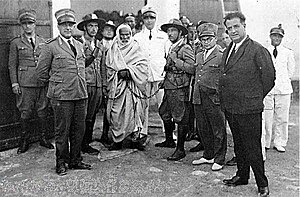
Back إخماد الثورة الليبية Arabic Liviya soyqırımı Azerbaijani Zweiter Italienisch-Libyscher Krieg German Β΄ Ιταλο-Λιβυκός Πόλεμος Greek Pacificación de Libia Spanish Pacification de la Libye French Pasifikasi Libya ID Riconquista della Libia Italian Pacificação da Líbia Portuguese Национально-освободительная война в Ливии (1923—1932) Russian
You can help expand this article with text translated from the corresponding article in German. Click [show] for important translation instructions.
|
| Second Italo-Senussi War | |||||||
|---|---|---|---|---|---|---|---|
| Part of the interwar period | |||||||
 Senussi rebel leader Omar al-Mukhtar (the man in traditional clothing with a chain on his left arm) after his arrest by Italian armed forces in 1931. Mukhtar was executed in a public hanging shortly afterward. | |||||||
| |||||||
| Belligerents | |||||||
|
|
| ||||||
| Commanders and leaders | |||||||
|
|
| ||||||
| Casualties and losses | |||||||
| 2,582 deaths[2] | 40,000–70,000 deaths[3] | ||||||
The Second Italo-Senussi War, also referred to as the Pacification of Libya, was a conflict that occurred during the Italian colonization of Libya between Italian military forces (composed mainly by colonial troops from Libya, Eritrea, and Somalia)[4] and indigenous rebels associated with the Senussi Order. The war lasted from 1923 until 1932,[5][6][7] when the principal Senussi leader, Omar al-Mukhtar, was captured and executed.[8] The Libyan genocide took place during and after the conflict.
| Events leading to World War II |
|---|
Fighting took place in all three of Libya's provinces (Tripolitania, Fezzan, and Cyrenaica), but was most intense and prolonged in the mountainous Jebel Akhdar region of Cyrenaica.[9] The war led to the mass deaths of the indigenous people of Cyrenaica, totalling one quarter of the region's population of 225,000.[10] Italian war crimes included the use of chemical weapons, execution of surrendering combatants, and the mass killing of civilians,[1] while the Senussis were accused of torture and mutilation of captured Italians and refusal to take prisoners since the late 1910s.[11][12][13] Italian authorities forcibly expelled 100,000 Bedouin Cyrenaicans, half the population of Cyrenaica, from their settlements, many of which were then given to Italian settlers.[14][15]
- ^ a b Duggan, Christopher (2007). The Force of Destiny: A History of Italy Since 1796. New York: Houghton Mifflin. p. 497.
- ^ John Gooch: Mussolini’s War: Fascist Italy from Triumph to Collapse, 1935–1943. o. O. 2020, S. 9.
- ^ Angelo Del Boca; Anthony Shugaar (2011). Mohamed Fekini and the Fight to Free Libya. Palgrave Macmillan. p. 5. ISBN 9780230116337.
between 40,000 and 70,000 deaths due to forced deportations, starvation and disease inside the concentration camps, and hanging and executions
- ^ Nir Arielli (2015). "Colonial Soldiers in Italian Counter-Insurgency Operations in Libya, 1922-32". British Journal for Military History. 1 (2): 47–66.
- ^ Cooper, Tom; Grandolini, Albert (19 January 2015). Libyan Air Wars: Part 1: 1973-1985. Helion and Company. p. 5. ISBN 9781910777510.
- ^ Nina Consuelo Epton, Oasis Kingdom: The Libyan Story (New York: Roy Publishers, 1953), p. 126.
- ^ Stewart, C. C. (1986). "Islam". The Cambridge History of Africa, Volume 7: c. 1905 – c. 1940 (PDF). Cambridge, United Kingdom: Cambridge University Press. p. 196. Archived from the original (PDF) on 6 August 2017.
- ^ "Regio Esercito - MVSN - Riconquista della Libia 1923-1931". www.regioesercito.it.
- ^ The Second Italo-Senussi War http://countrystudies.us/libya/21.htm retrvd 2-1-20
- ^ Mann, Michael (2006). The Dark Side of Democracy: Explaining Ethnic Cleansing. Cambridge University Press. p. 309. ISBN 9780521538541.
- ^ Gaston Leroud, Matin Journal edition August 23, 1917
- ^ John Gooch (19 June 2014). The Italian Army and the First World War. Cambridge University Press. pp. 44–. ISBN 978-0-521-19307-8.
- ^ Robert Gerwarth, Erez Manela (3 July 2014). Empires at War: 1911-1923. OUP Oxford. p. 17. ISBN 978-0-19-100694-4.
- ^ Cardoza, Anthony L. (2006). Benito Mussolini: the first fascist. Pearson Longman. p. 109.
- ^ Bloxham, Donald; Moses, A. Dirk (2010). The Oxford Handbook of Genocide Studies. Oxford, England: Oxford University Press. p. 358.